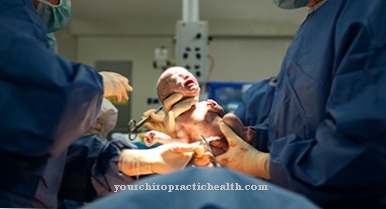The idiopathic interstitial pneumonia unites a large group of lung diseases that have the components inflammation and lung scarring in common in different forms. The causes are unknown. Therapeutically, the inflammatory process is primarily suppressed so that the disease process is ideally stopped. If treatment fails, a lung transplant should be considered at an early stage.
What is idiopathic interstitial pneumonia?

© Alila Medical Media - stock.adobe.com
The idiopathic interstitial pneumonia is an umbrella term for a large group of diseases of the lungs with an inflammatory reaction and lung scarring (fibrosis) of the connective tissue, capillaries and / or alveoli. Various forms of the disease are subsumed under this, which differ in the extent of lung damage, pathology, symptoms, course of the disease and therapeutic options.
In 2002 the American Thoracic Society and the European Respiratory Society published a joint classification of idiopathic interstitial pneumonia. A total of seven forms of disease are currently distinguished:
- idiopathic pulmonary fibrosis
- non-specific interstitial pneumonia
- cryptogenic organizing pneumonia
- acute interstitial pneumonia
- respiratory bronchiolitis with interstitial lung disease
- desquamative interstitial pneumonia
- lymphoid interstitial pneumonia.
causes
The exact cause of idiopathic interstitial pneumonia is not known. Pathogenetically, inflammation and fibrosis are in the foreground. Based on lung biopsy results, the following concept for disease development currently exists. Initially, there is damage to the alveoli, which leads to the activation of inflammatory cells.
These inflammatory cells emit certain messenger substances that lead to the migration of white blood cells (leukocytes) into the alveoli. This in turn activates granulocytes, which then release proteases and toxic oxygen metabolites. This leads to further damage to the alveoli and to disturbance of the surfactant formation in the alveoli, which then collapse.
In addition, fibroblasts multiply via a lymphocytic inflammation, which remodel the connective tissue, the capillaries and the alveoli. As a result, the alveoli are also cut off from the blood and oxygen supply and the further formation of scar fields increases. The remaining, still ventilated alveoli are compensatory over-inflated and form into cystic cavities that resemble honeycombs.
Symptoms, ailments & signs
The main symptoms of idiopathic interstitial pneumonia are shortness of breath and a dry cough. At the beginning, the shortness of breath is only noticed during physical exertion and progresses in the course of the disease, so that then there is also a shortness of breath at rest. In the end-stage, respiratory insufficiency with exhaustion of breathing can occur.
The symptoms of respiratory insufficiency of dyspnoea and dry cough are chronic in most patients, i.e. for months or years before the diagnosis is made. Due to the restructuring of connective tissue, the gas exchange in the lungs is disturbed, resulting in a lack of oxygen (hypoxemia) in the blood. Hypoxemia causes the skin and mucous membranes to turn a visible bluish color, known as cyanosis.
The lips, fingers, and toes in particular become cyanotic. If cyanosis persists, drumstick fingers and watch glass nails typically develop. The disease usually manifests itself in the second to fourth decade of life. The patients with idiopathic pulmonary fibrosis are usually older than 60 years.
Diagnosis & course of disease
The diagnosis of idiopathic interstitial pneumonia is made clinically, radiologically, and pathologically. At the beginning there is the anamnesis and physical examination. Current complaints, previous illnesses, medication intake and family history are queried from the medical history.
During the physical examination, the lungs are percussed and auscultated with a stethoscope. A dry end-inspiratory crackle and fine-bubble rattling noises can often be heard. With advanced disease, cyanosis, watch glass nails and drumstick fingers can appear as skin symptoms. If idiopathic interstitial pneumonia is suspected, lung function and imaging diagnostics with an X-ray or high-resolution computed tomography (CT) are carried out.
Typical signs are spotty, reticular compaction, bulging of the bronchi and a honeycomb formation. If the diagnosis is still unclear after imaging, bronchoscopy with bronchoalveolar lavage and biopsy is indicated. The lung biopsy is generally the most reliable method to confirm the diagnosis of the disease and to initiate adequate therapy.
The course of the disease is sometimes very variable, but most diseases progress insidiously. Sometimes patients who have had a chronic cough or shortness of breath for months or years only consult a doctor late. As a result, the corresponding diagnosis is made late and the fibrotic remodeling has already taken place.
Complications
This disease causes considerable discomfort and complications in the lungs and airways. In severe cases, therapy or treatment is not possible and the affected person is dependent on a donor lung transplant. As a rule, those affected suffer from shortness of breath and a strong cough. Coughing up blood can also occur, which often triggers a panic attack.
Due to breathing difficulties, organs and extremities are often not supplied with enough oxygen and can be damaged as a result. Likewise, the patient is no longer so resilient and cannot do any particular physical activities or sports. This disease severely limits the patient's quality of life. The shortness of breath can also lead to a loss of consciousness, in which the person affected can be injured by falling.
The disease is usually treated with the help of medication. Unfortunately, no causal treatment is possible, so the symptoms must be limited. However, this does not always lead to success. If the treatment is unsuccessful and no lungs are found for the person concerned, the death of the patient is almost inevitable.
When should you go to the doctor?
A doctor's visit is required in the event of breathing disorders. If the abnormalities persist for several days or weeks, a doctor must examine the lungs and the airways. Coughing, difficult breathing, pauses in breathing or dry mouth are indications that should be investigated. If you feel pressure in your chest, you get tired quickly during physical activity, or you hear breathing noises, a doctor's visit is necessary. Often the person concerned suffers from a gradual process of change. Since an organ transplant becomes necessary in severe cases, it is advisable to visit a doctor in good time at the first signs of this.
If the skin becomes discolored, the disease is already advanced. Blue discoloration of the lips, toes or fingers should therefore be presented to a doctor as soon as possible. If the person concerned has a vague feeling of illness, notices a general malaise or if the usual level of performance drops, a doctor should be consulted. Changes or deformations of the fingers are considered unusual and should be examined by a doctor. A doctor should be consulted in the event of fear, panic behavior or feelings of suffocation. If dizziness sets in, if you feel unsteady, or if you can no longer carry out normal sporting activities, a doctor's visit is necessary to determine the cause. A doctor should be consulted in the event of insomnia, increased irritability or impaired attention.
Doctors & therapists in your area
Treatment & Therapy
The main goal of treatment is to prevent lung fibrosis from progressing, as it is irreversible. Known triggers should be eliminated and the acute or chronic inflammatory process aggressively suppressed. Two groups of drugs are mainly used in therapy.
On the one hand the glucocorticoids and on the other hand the immunosuppressants. The effectiveness of the medication varies depending on the type of illness. Idiopathic pulmonary fibrosis, for example, was previously not effectively treatable with glucocorticoids or immunosuppressants, but the drugs pirfenidone and nintedanib have now been approved.
It is antifibrotic drugs that slow down the course of the disease. Other subtypes of idiopathic interstitial pneumonia respond well to anti-inflammatory therapy. If there is hypoxemia at rest or during exercise, oxygen therapy should be considered. In many patients the disease is chronic and irreversible, despite therapy, so that a lung transplant should be considered at an early stage.
Outlook & forecast
The prognosis of idiopathic interstitial pneumonia is individual and must be based on the patient's personal health. Basically, it is classified as unfavorable because a cure is not to be expected. The damage to the inflammatory process of the lungs cannot be repaired according to the current state of science and medicine, despite all efforts.
In severe cases, there is a risk of organ transplantation or premature death, as there is a risk of organ failure. If the therapy is successful, the prognosis improves. If the diagnosis is made early and treatment is started as soon as possible, the progression of the disease can be greatly influenced. The chronically progressive inflammation can be inhibited by administering medication.
If a donor lung is necessary to maintain the patient's survival, the usual risks and side effects of the surgical procedure must be taken into account. Nevertheless, there is the possibility of a significant improvement in health and a life extension. However, if the organism rejects the donor organ, the prognosis worsens.
The disease has sequelae in many patients. Fear, lifestyle restrictions and the restructuring of everyday life can lead to stress and trigger new diseases. This leads to a worsening of the overall prognosis, since the psyche has a significant share in the recovery process.
prevention
Since the exact causes of the disease complex are unknown, no specific measures can currently be named that serve for prevention. Only general behavior can be formulated. Nicotine, drug or medication abuse should be avoided. Physical activity and a healthy diet are generally beneficial.
Aftercare
In idiopathic interstitial pneumonia, follow-up care is closely related to therapy. The goal is to suppress the process of inflammation and prevent the lung fibrosis from progressing. In this way, the course of the disease can ideally stop.Doctors prescribe medication to remove the triggers.
At the same time, the drugs actively counteract the inflammatory process. Patients should strictly follow the doctor's instructions and take the antifibrotic agents as directed. In this way they manage to slow down the further course of the disease. Anti-inflammatory treatment may also be used depending on the type of condition.
If the problem is hypoxemia, your doctor may recommend oxygen therapy. When deciding on the right form of treatment, patients need specialist advice. It is also important to have regular check-ups to see how the disease is developing. Even with targeted therapy, the disease can progress irreversibly, and a lung transplant may then be useful.
The actual triggers for the disease can often not be identified. That is why there are no concrete help measures, only assistance for a health-conscious lifestyle. Avoiding nicotine, drugs and medication, combined with a balanced diet and physical activity, has a positive effect.
You can do that yourself
The number one concern for patients with idiopathic interstitial pneumonia is to stop the inflammation in the lungs and support medical efforts. Due to the seriousness of the illness, the doctor's instructions take precedence over all other information and self-help measures. In addition, all independent approaches must be discussed with the doctor beforehand.
Usually, patients with idiopathic interstitial pneumonia are given various medications that must be taken on time and regularly. Since these are immunosuppressants, among other things, those affected are more careful not to overload their immune system. So those affected apply suitable hygiene measures and avoid getting infected with other people. In this sense, it is also beneficial to rest regularly in the case of idiopathic interstitial pneumonia.
Sports activities can often no longer be carried out to the same extent as before the illness. However, completely avoiding physical training is not always necessary or beneficial. The doctor often refers the patient to a physiotherapist, who sets up a training concept adapted to the idiopathic interstitial pneumonia. As with all lung diseases, with idiopathic interstitial pneumonia it is imperative to completely quit smoking immediately.




.jpg)

.jpg)





.jpg)



.jpg)










.jpg)
